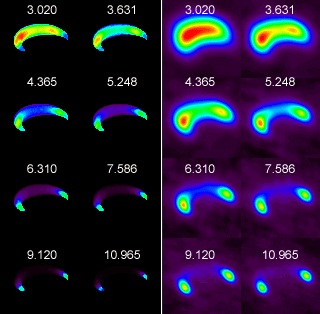Quick Links
Data Archive
Download data from recent and current EOVSA's missions.
Direct MeEOVSA Documentations
Access to EOVSA documents, including such as hardware, software, calibration and observing log.
Direct MeObserving Status
Check current antenna status, observing coverage and EOVSA dynamic spectrum.
Direct MeSummary
The New Jersey Institute of Technology (NJIT) is now embarking on a major expansion of OVSA, funded by NSF using American Recovery and Reinvestment Act (ARRA) funds. The project expands OVSA from its current complement of 7 antennas to a total of 15 by adding 8 new antennas, and replaces the existing control systems, wiring, and signal processing with modern, far more capable and reliable systems based on newly developing technology. In so doing, we will create a university-led community facility that will address a broad range of new science that will serve the scientific community. The project will support that community by providing open data access and software tools for analysis of the data, to exploit synergies with on-going solar research in other wavelength bands. The project will result in a world-class facility for scientific research at microwave radio frequencies (1-18 GHz) in areas of important national interest, such as understanding the Sun's influence on the Earth and near-Earth space environment—a subject broadly termed Space Weather. The solar science to be addressed focuses on the magnetic structure of the solar corona, on transient phenomena resulting from magnetic interactions, including the sudden release of energy and subsequent particle acceleration and heating, and on space weather phenomena. The project also includes an exciting program of targeted astronomical science. The non-solar science exploits the large amount of available observing time when the array is not used for solar work, to do search, follow-up, and monitoring of transient radio astronomical sources. The project will be completed in time to provide solar-dedicated observations during the upcoming solar maximum in 2013 and beyond.
Learn More

Science
The range of science to be conducted with the Expanded OVSA is broad and unique. Check out the science page for more on each topic.
- Magnetic and Plasma Structure Above Active Regions
- Coronal Magnetography
- Temperature, Density, Nonthermal Electrons
- Flaring Loops and Particle Acceleration in Solar Flares
- Electrons and Magnetic Fields in Flaring Loops
- Dynamic Imaging and Turbulence
- Drivers of Space Weather
- F10.7 Images
- Eruptive Events
- Night-Time Observations of Variable and Transient Sources
- Blazars
- Long Duration Radio Transients (LDRTs)

About the Instrument
The OVSA Expansion calls for a complete redesign of the array, adding 8 new 2-m antennas, and moving the 5 existing 2-m antennas to new locations. These 13 antennas provide 78 baselines for imaging. The two 27-m antennas will be completely refurbished and modernized with new control systems and cooled receivers, for both night-time science and calibration of the array. The maximum baseline will grow to more than 1.5 km, for a typical resolution (varies by time of day and season) of about 60"/n GHz. The table at right summarizes the expected instrument parameters. Below are some highlights of the instrument specifications. These are subject to change as the design becomes more detailed during development.
Learn More
| OVSA Expansion Project Instrument |
|